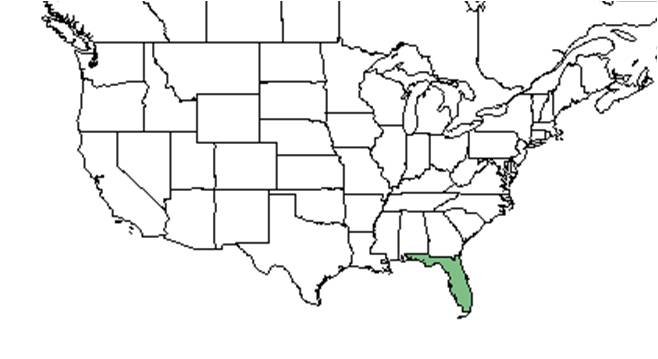Difference between revisions of "Chapmannia floridana"
KatieMccoy (talk | contribs) |
KatieMccoy (talk | contribs) |
||
| Line 39: | Line 39: | ||
===Seed bank and germination=== | ===Seed bank and germination=== | ||
===Fire ecology=== <!--Fire tolerance, fire dependence, adaptive fire responses--> | ===Fire ecology=== <!--Fire tolerance, fire dependence, adaptive fire responses--> | ||
| + | Carrington (1999) found ''C. floridana'' to be a strong re-sprouter after fire, however it did not show a strong flowering response. Seedlings were only present for five months post-fire, suggesting a weak seedling establishment after fire (Carrington 1999). Populations have been observed to be low in undisturbed, burned areas (Mayfield 1998). | ||
| + | |||
===Pollination=== | ===Pollination=== | ||
The following Hymenoptera families and species were observed visiting flowers of ''Chapmannia floridana'' at Archbold Biological Station (Deyrup 2015): | The following Hymenoptera families and species were observed visiting flowers of ''Chapmannia floridana'' at Archbold Biological Station (Deyrup 2015): | ||
Revision as of 16:04, 4 December 2015
| Chapmannia floridana | |
|---|---|

| |
| Scientific classification | |
| Kingdom: | Plantae |
| Division: | Magnoliophyta - Flowering plants |
| Class: | Magnoliopsida - Dicotyledons |
| Order: | Fabales |
| Family: | Fabaceae ⁄ Leguminosae |
| Genus: | Chapmannia |
| Species: | C. floridana |
| Binomial name | |
| Chapmannia floridana Torr. & A. Gray | |

| |
| Natural range of Chapmannia floridana from USDA NRCS Plants Database. | |
Common name: Florida alicia
Contents
Taxonomic notes
Description
C. floridana is an erect perennial herb arising from a fleshy tap root and can reach three feet in height (Gunn et al. 1980). All parts of the plant are covered with sticky hairs and leaves are alternately arranged [1]. It is a nitrogen fixer (Mayfield 1998).
Distribution
It is endemic to Florida [1].
Ecology
Habitat
In the Coastal Plain in Florida, C. floridana has been found in turkey oak/longleaf pine sand ridges; pine-palmettos flatwoods; longleaf pine-wiregrass ridges; and scrub oak sand ridges. It is found in large populations in highly disturbed areas compared to undisturbed areas, making it unusual from other Florida endemic scrub species which are sensitive to disturbance (Mayfield 1998). Populations have been found in disturbed areas such as heavily cattle grazed longleaf pine-saw palmetto flatwoods, roadsides, and pastures (FSU Herbarium; Mayfield 1998).
Phenology
Flowers are yellow and orange and are composed of three petals [1]. It flowers May through June and fruits in May (FSU Herbarium).
Seed dispersal
Seed bank and germination
Fire ecology
Carrington (1999) found C. floridana to be a strong re-sprouter after fire, however it did not show a strong flowering response. Seedlings were only present for five months post-fire, suggesting a weak seedling establishment after fire (Carrington 1999). Populations have been observed to be low in undisturbed, burned areas (Mayfield 1998).
Pollination
The following Hymenoptera families and species were observed visiting flowers of Chapmannia floridana at Archbold Biological Station (Deyrup 2015):
Apidae: Bombus impatiens
Halictidae: Augochlorella aurata, Augochloropsis metallica, Lasioglossum nymphalis, L. placidensis
Use by animals
Diseases and parasites
Conservation and Management
Cultivation and restoration
Photo Gallery
References and notes
Deyrup, M.A. and N.D. 2015. Database of observations of Hymenoptera visitations to flowers of plants on Archbold Biological Station, Florida, USA.
Florida State University Robert K. Godfrey Herbarium database. URL: http://herbarium.bio.fsu.edu. Last accessed: October 2015. Collectors: Loran C. Anderson, J. Beckner, D. Burch, J. Carmichael, A. Gholson Jr., R.K. Godfrey, Richard D. Houk, R. Kral, K.M. Meyer, Allen G. Shuey, A. Townesmith, D.B. Ward. States and Counties: Florida: Clay, DeSoto, Glades, Lake, Marion, Orange, Osceola, Polk, Seminole. Compiled by Tall Timbers Research Station and Land Conservancy.
- ↑ 1.0 1.1 1.2 [Native Florida Wildflowers]Accessed: December 4, 2015